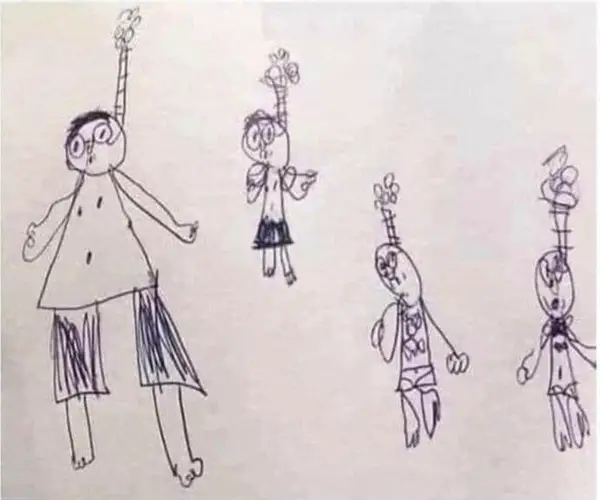A young boy’s innocent drawing of his family during a classroom assignment caused a surprising reaction from his teacher, leading to an emergency meeting with his parents. The teacher was alarmed when the child’s artwork depicted family members with what appeared to be ropes around their necks. Unbeknownst to her, the drawing was a simple portrayal of the family snorkeling in the Bahamas.
This incident quickly turned into a humorous family anecdote, with the father sharing it online, where it sparked debates on whether the teacher overreacted or acted responsibly. Some believed the teacher should have simply asked the child for clarification, while others felt it was better to be cautious, stating that such interventions, even if mistaken, can sometimes save lives.
The Overreaction or Justified Concern Debate
Incidents like these tend to stir up a larger conversation about how educators should handle potentially alarming situations involving young children. The teacher’s decision to call for an emergency meeting based on the drawing’s appearance drew mixed reactions from the online community.
One side argued that such a reaction was overly dramatic. After all, children’s drawings can often be misunderstood, and rushing to conclusions can create unnecessary panic. As one commenter put it, “This is bloody hysteria. Seriously, who needs that drama?” Others echoed similar sentiments, suggesting that a simple conversation with the child could have clarified the situation, avoiding the need for an emergency meeting.
The Case for Caution
However, not everyone saw the teacher’s reaction as an overreach. Several commenters supported the teacher’s decision, emphasizing that it’s better to err on the side of caution when it comes to children’s welfare. The argument here is that, in cases where there’s even a small chance of something being wrong at home, it’s crucial to investigate thoroughly.
As one user remarked, “I would want to know, even if it’s a false alarm… it’s better safe than sorry.” From this perspective, the teacher’s actions, though ultimately unnecessary, were a reflection of due diligence, ensuring the child’s safety and well-being. Another commenter pointed out that these kinds of checks have saved lives in the past, implying that while this incident turned out to be a misunderstanding, similar cases could reveal real problems.
Children’s Innocence and Creativity
The story also brings to light the importance of understanding how children express themselves creatively. For children, drawing can be an innocent and fun activity, but adults sometimes misinterpret their art, projecting their own concerns onto a child’s creation. What may look like something alarming to an adult could simply be a child’s attempt to convey a happy memory, as was the case with this boy’s snorkeling experience.
One commenter reflected this sentiment, stating, “What kind of teacher was this? Children are innocent… they take pleasure from innocent drawings.” This speaks to the often-blurry line between children’s art and adult interpretation, reminding us that we should approach children’s expressions with an open mind.
The Role of Teachers in Ensuring Safety
In situations like this, teachers are put in a tough spot. They are entrusted with the safety of their students and have to balance vigilance with restraint. While this particular case might have ended with some laughter, the teacher’s actions highlight a broader issue: how to handle potential red flags without jumping to conclusions or creating unnecessary anxiety. The teacher’s approach, while debatable, was likely driven by a genuine concern for the child’s safety.
This incident serves as a reminder of the vital role teachers play not only in education but also in safeguarding the children they work with. While the situation could have been resolved with a simple question to the child, the teacher’s instincts, albeit misguided in this instance, were rooted in the well-being of the student.
The Balance Between Vigilance and Overreaction
Ultimately, this story highlights the delicate balance teachers and educators must strike in their role as caretakers of children. There is no question that educators need to be vigilant, but they also must be careful not to overreact to situations that might simply be the result of a child’s imagination.
This story, although funny in hindsight, sheds light on the importance of open communication between teachers, students, and parents. By fostering a trusting environment where children feel comfortable explaining their thoughts and creations, teachers can avoid unnecessary panic while still maintaining the safety of their students.
In conclusion, while this particular event ended in smiles and laughter, it serves as an important conversation starter about how we interpret children’s actions and expressions. It reminds us that, sometimes, a simple conversation can clear up misunderstandings, but also emphasizes that taking precautions—even when they seem excessive—can be crucial in ensuring children’s safety.
Takeaways: Was the Reaction Overblown?
The internet’s response to this family’s situation shows how divided opinions can be on such matters. Some feel the teacher acted responsibly, while others saw it as an overblown reaction to an innocent drawing. Regardless of which side you agree with, the story is a reminder of how easily misunderstandings can arise from everyday situations, especially when dealing with children.
What’s your take on this incident? Do you think the teacher was right to call the emergency meeting, or should she have approached it differently?

